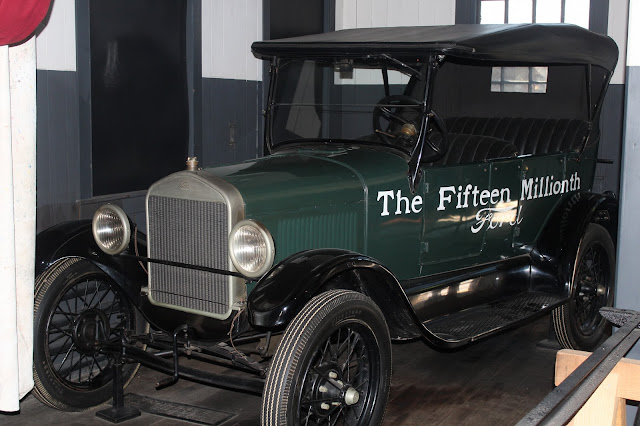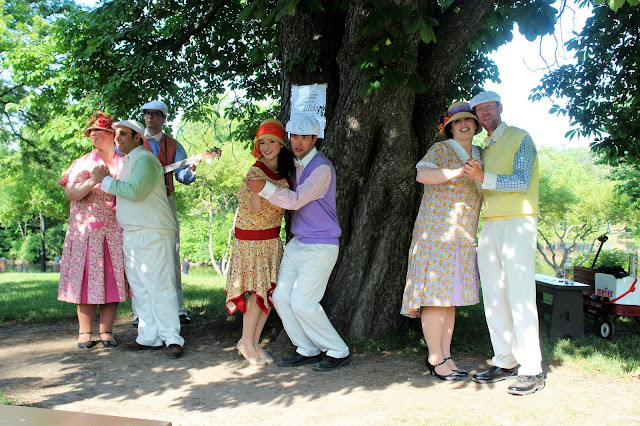Driving back to Dearborn, our afternoon was spent at Greenfield Village, the outdoor "living history" museum adjacent to the Henry Ford Museum. It was opened to the public in 1933 and was the first outdoor museum of its kind in the United States. It comprises 240 acres, of which 90 are for exhbitis and the remainder being natural landscape.
In addition to the 100 buildings to be visited at the site, Greenfield Village also hosts a number of special events, including two car shows. There is one for early cars (1890-1932) each September and the Motor Muster, for cars built between 1932-1976, which we were fortunate in our timing to be able to see.
Upon entering the park, we could not resist taking a ride on the beautiful vintage steam train, the Weiser Railroad, that circles the village. It has a 2 mile route and four stops and the beautiful roundhouse is a modern replica of one built in 1884. Our locomotive, one of three in inventory, was "Edison," built in 1870.
 |
| Something a bit unusual: Amish tourists |
As the train circled Greenfield Village, we had a nice view of the many attractions. One of these is an old time baseball field, where a game was in progress. The players stopped briefly to tip their caps and wave to us. Greenfield Village keeps traditional "base ball" as it is called alive and hosts the World Tournament of Historic Base Ball each August. There is a Vintage Base Ball Assocation and teams are fielded throughout the USA. This version of the sport is pre-the professional era in style and values sportsmanship. The gentleman's game does not appear to use protective gear or even gloves but the outfits are very nice. The Greenfield Village team is The La-De-Dahs.
Passing farmsteads and a lovely covered bridge, we arrived at our station and prepared to enjoy the sights and sounds of Greenfield Village and the Motor Muster. It was a very hot and sunny day and everyone was in good spirits.
 |
| 1956 Continental Mark II |
 |
| 1957 Ford Thunderbird |
After watching the cars drive by--and we would have the chance to look at them more closely as they were parked throughout the village--we decided to start looking at the different buildings on offer.
For me one of the great treasures of the village is the Wright Brothers' bicycle shop, moved to Michigan from its original location in Dayton, Ohio. It was accompanied by the brothers' boyhood home as well.
 |
| The Wright house, built in 1870. It was here that Orville was born in 1871 and Wilbur died in 1912. |
There were, unsurprisingly, many objects related to Henry Ford. In addition to the numerous Ford Model Ts zipping around the village ($5 a ride and remarkably quiet), there was a scaled replica of Henry Ford's first factory, which contained the 15 Millionth Ford car, as well as the original workshop where he built his first car, the Quadricycle, in 1896.
In a courtyard next to the Quadricycle workshop/shed there was a demonstration of the "kitchen sink" engine, the model that Henry Ford built for his car based on plans in a magazine. To test it, he bolted it to the kitchen sink and ran it there. It was fascinating to see this early technology in action, with fuel having to be dripped down into the engine as there was no such thing as a carburetor yet.
As an aside, the plans that Henry worked from had been drafted by a rather crooked promoter of early car companies and it is considered remarkable that given his history it actually worked!
Another demonstration was a real chance to history in action. Henry Ford was a huge admirer of Thomas Edison, having worked for him as an engineer, and a big celebration was held in Greenfield Village in 1929 marking the fiftieth anniversary of the invention of the electric light, surely a major milestone for humanity. Edison himself was present for the event, which took place in Greenfield Village's reconstruction of Edison's Menlo Park, New Jersey, laboratory complex. The buildings are filled with interesting objects as they would have been in Edison's time. The chair where he sat for the ceremonies was nailed to floor, Ford saying it would never be moved. At one point the floors were replaced but the area under Edison's chair remains as it was.
 |
| Edison's chair is on the left; note the original floor! |
In addition to all the electrical and chemical equipment found in the lab buildings, we were given a demonstration of Edison's phonograph, which required the user to speak into a trumpet while a needle recorded the sound on tinfoil. The demonstrator recited "Mary Had a Little Lamb," just as Edison himself did in 1877, and played back the faint, tinny recording. Edison did not see much future for his invention except as a dictaphone but this little device led to our vast treasury of recorded sound. The replica phonograph used for the demonstration was made by a mechanic from Michigan and donated to the museum in 2014.
The demonstrator was so pleased by our interest in the device that he gave us the tinfoil sheet used to make the recording.
Old Henry Ford was so keen on Thomas Edison that he even arranged to have the Canadian home of Edison's grandparents brought from Vienna, Ontario, to Greenfield, Village. I had to look it up: Vienna is a tiny village near Lake Erie, around 60 kms southeast of London, Ontario. There is actually an Edison Museum on 14 Snow Street in Vienna which has family mementos. However, "due to structural deficiencies the Edison Museum has been closed indefinitely."
 |
| Edison home, relocated from Vienna, Ontario |
We continued our walk through the village, stopping to admire the many beautiful old cars on display.
 |
| 1948 Cadillac convertible |
 |
| 1962 Lincoln Continental sedan |
 |
| Volkswagen Beer Truck, sadly with only empty cases |
 |
| 1930s Dodge |
 |
| American Bantam cars, built on imported Austin components |
 |
| 1964 Lincoln Continental limousine used by Pope Paul II on his visit to the United States, a new acquisition by the Henry Ford Museum in 2016 |
Not only were interesting cars parked throughout the village, but there was live entertainment as well. A group in costume performed various songs from the 1920s and 1930s, including some familiar Gershwin numbers.
And as it was very hot we looked for some refreshment. There is a a very fine old tavern on the grounds. Originally constructed as the Clinton Inn in 1831 and renamed the Eagle Tavern in 1849, it serves authentic food from the period and is a popular dining spot. I chatted with the proprietor and his friend and was persuaded to try the tavern's homemade sarsparilla, which was very welcome and refreshing. Someone has written an excellent blog about Greenfield Village and offers up this detailed history of the Eagle Tavern here.
At the end of the day there was a Sixties Dance Party on the main street. A British DJ was chauffeured to the grandstand and a group of young people danced vintage dances from the era of the British Invasion. A group came on stage and lip-synched to "I'm Telling You Now," the one big hit of Freddy and the Dreamers. Subsequently, the dancers were instructed to "do the Freddy," a dance that would take a gold medal for awkwardness. It was all good fun.
 |
| Doing the Freddy |
Tired but happy, we made our way past a lovely mill and a wonderful steam tractor and headed for the exit. We spend a half day in Greenfield Village but will return as there was so much we did not have a chance to see. Henry Ford famously remarked "History is bunk" but in his later, declining years spent a lot of time just hanging around in Greenfield Village. One has the sense that the man who put the world on wheels, who was responsible perhaps more than anyone else for the modern world in so many ways, wanted to somehow put the genie back into the bottle and return to a quieter age.
































No comments:
Post a Comment